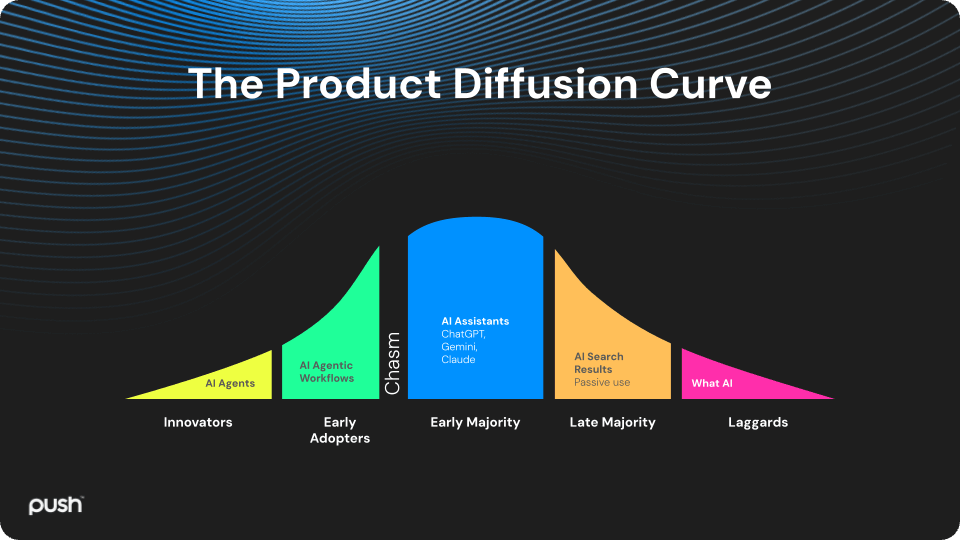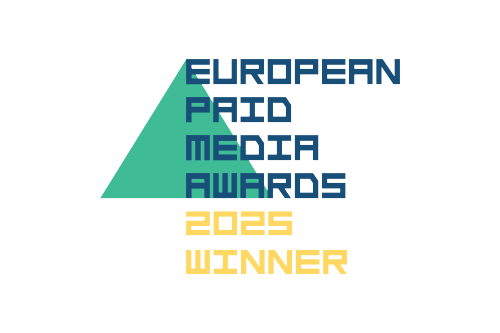It maps out how new products and innovations are adopted across five key segments.
- Innovators
- Early Adopters
- Early Majority
- Late Majority
- Laggards.
But in the age of Artificial Intelligence (AI), this classic bell curve is being redrawn in real time, with industry experts like Scott Brinker at the forefront of understanding what’s changing and why.
The Product Diffusion Curve
The Product Diffusion Curve illustrates how different groups embrace innovation at different rates:
Traditionally, products move steadily through these phases. But the AI era is compressing timelines and reshaping adoption patterns.
At Push, we’ve always believed in staying ahead of the curve, literally. As early adopters of AI, we gained priority access to Microsoft’s ChatGPT beta in 2020, integrating it by 2022 to create ad copy, discover keywords, and dynamically optimise campaigns. This positioned us firmly among the innovators and early adopters, leveraging AI not just for efficiency, but to fundamentally transform how we deliver value to clients.
AI and the New Dynamics of Diffusion
Scott Brinker, editor of Chiefmartec.com and a leading voice in marketing technology, has observed that AI is accelerating the product adoption process. Take the example of ChatGPT; within two months of launch, it reached over 100 million users, something that would have taken years for most technologies in the past.
This kind of rapid, global uptake challenges the idea that every innovation must spend years "crossing the chasm" from early adopters to the early majority.

Brinker notes that AI is not just another tool, it’s a catalyst that fundamentally changes how marketers and consumers interact with technology. The adoption curve is flattening and shifting, with innovations leaping from innovators to the mainstream almost overnight.
AI as an Enhancer, Not a Replacement
Brinker argues that AI’s role in marketing is to augment, not replace, human creativity and decision-making. He sees AI as a “power boost” that allows marketers to harness data, automate routine tasks, and focus on strategy and storytelling.
In his view, the marketers who thrive will be those who learn to use AI as a tool, those who can “cross the chasm” between using AI for novelty and truly integrating it into their daily workflows.
He also emphasises the democratising power of AI; where once only specialists could analyse large datasets, now frontline marketers can access insights on demand, thanks to AI-driven analytics and content intelligence tools.
At Push, this philosophy guided our strategy. Our Digital Innovation and Automation Lab (DIAL) quickly put ChatGPT to work, experimenting to make PPC and SEO campaigns smarter and more effective. By late 2022, AI was woven into daily routines for crafting tailored ad copy, uncovering valuable keyword opportunities, and predicting campaign performance. Our ongoing collaboration with Microsoft, and the development of DIAL Agents, allowed us to leverage AI’s full capabilities while keeping client data safe and confidential.
The results speak for themselves; DIAL Agents enabled us to handle more complex and nuanced marketing briefs, delivering faster and more accurate solutions. This approach not only addressed clients’ security concerns but also set a new standard for AI-driven marketing. Most notably, it helped us win the global Clarks Shoes account, competing successfully against far larger agencies and demonstrating how early, secure adoption of AI can deliver industry-leading results.
The Curve in the AI Era
- Compressed Timelines
AI products, thanks to their utility and viral potential, can move from innovation to mainstream adoption at unprecedented speeds.
- Ecosystem Integration
Modern AI tools rarely exist in isolation. Their rapid diffusion is often powered by compatibility with existing platforms and the ability to plug into broader digital ecosystems. - Continuous Feedback
AI-driven products can iterate and improve in real time, responding to user feedback and evolving needs, making the adoption process more dynamic and less linear than ever before.
What’s Next? Action Steps for Modern Marketers
Scott Brinker, emphasises that AI isn’t about replacing marketers, it’s about amplifying their creativity and strategic impact. Drawing on his insights and the latest industry research, here are practical steps to future-proof your marketing approach:
- Audit your current stack
Identify redundancies and opportunities for integration, ensuring your tools work together efficiently, a theme Scott Brinker highlights as essential for modern marketing operations. - Experiment with AI
Start small, but don’t be afraid to pilot new tools that can automate or enhance creative processes. As Brinker notes, marketers who differentiate themselves are those who use AI for both efficiency and innovation, not just as a shortcut. - Embrace modularity
Build a stack that can evolve as your business grows. Brinker’s annual Martech Landscape shows the value of flexibility in a rapidly expanding ecosystem. - Stay human
Use technology to amplify, not replace, your team’s unique insights and creativity. “The marketer is still in control,” Brinker reminds us, AI should broaden your horizons, not dictate your strategy.
As we look ahead, one thing is clear, Martech in 2025 isn’t just about having more tools, it’s about building smarter, more flexible systems that put marketers back in control. The future belongs to those who can blend technology and creativity to deliver truly exceptional customer experiences.








































